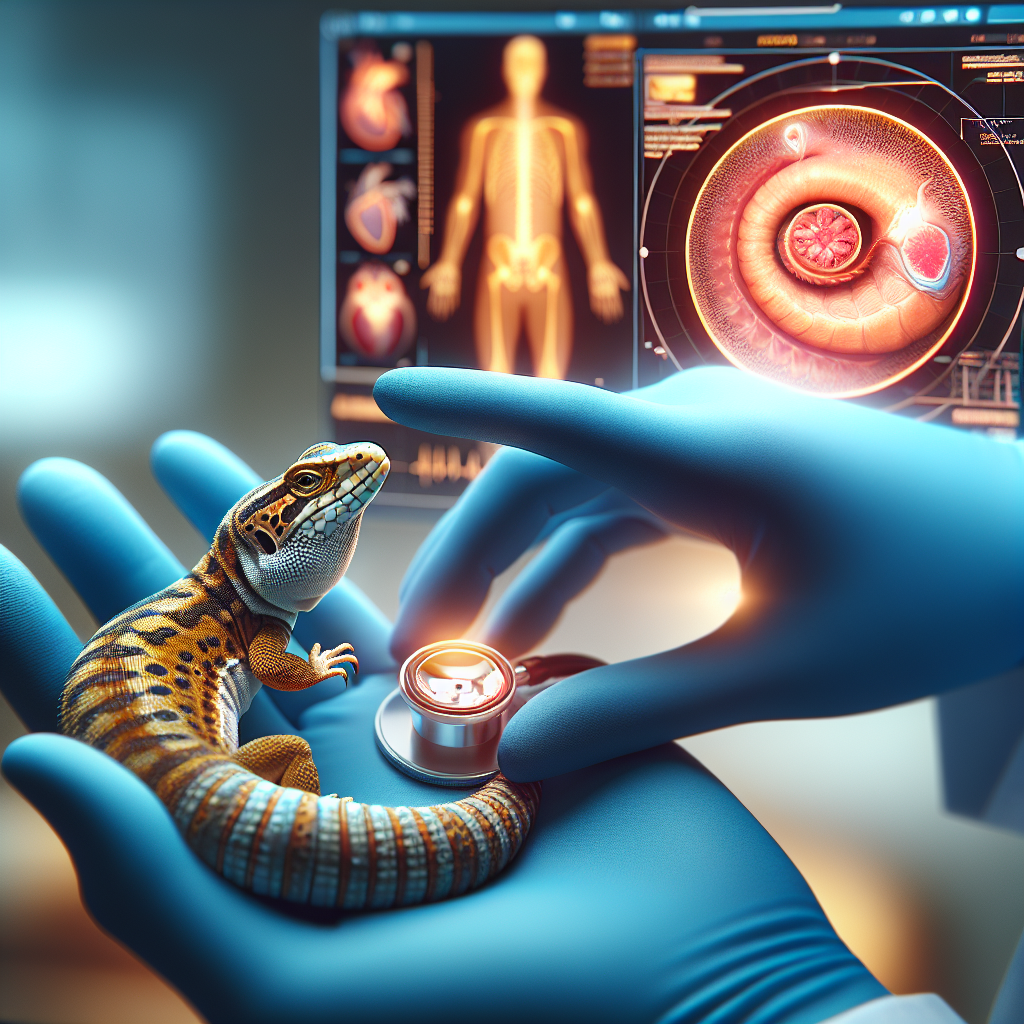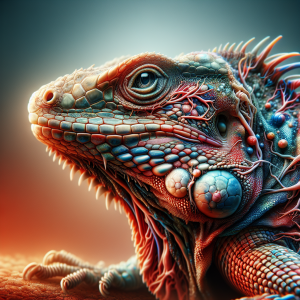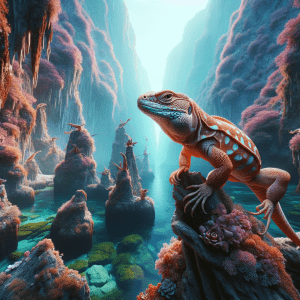Introduction: Importance of Lizard Health Imaging Diagnostics
Have you ever wondered how we can peek inside the tiny bodies of our scaly friends? It’s truly mind-boggling! Diagnostic imaging for lizards is like having a secret superpower – we can see what’s going on beneath those tough exteriors. Picture this: a lizard comes in for a check-up, and we whip out our imaging wizardry to reveal any hidden health concerns. It’s like being a detective in a reptilian mystery novel!
You see, diagnostic imaging isn’t just about snapping cool pictures; it’s a vital tool for ensuring our scaly pals stay healthy and happy. Imagine being able to catch potential health issues before they even show symptoms – that’s the magic of lizard imaging diagnostics. It’s like having a crystal ball that lets us peek into the future of their well-being.
Now, let’s dive deeper into the world of lizard health imaging. From X-rays to ultrasounds, each technique has its own superpowers in uncovering the mysteries of lizard health. Think of it as a high-tech treasure hunt, where each image reveals a piece of the puzzle. So, buckle up, because we’re about to embark on a thrilling journey through the fascinating world of lizard diagnostics. Get ready to be amazed at how a simple scan can unlock a world of health insights for our scaly companions!
Understanding the Different Imaging Techniques for Lizard Health
Understanding the Different Imaging Techniques for Lizard Health
When it comes to the health of your scaly companions, diagnostic imaging plays a crucial role. Just imagine being able to peek inside your lizard’s body without invasive procedures. Cool, right? Well, that’s the magic of imaging techniques like X-rays, ultrasounds, and CT scans. These tools allow us to see beyond the surface and identify any internal issues that may be affecting your lizard’s health.
Let me share a little insider tip with you – each imaging technique has its own strengths and limitations. For instance, X-rays are great for detecting bone fractures or foreign objects, while ultrasounds excel at visualizing soft tissues like organs. And CT scans? They provide detailed, 3D images that help us get a comprehensive view of your lizard’s insides.
Now, here’s a fun fact for you: Did you know that some lizards have small, specialized bones called osteoderms embedded in their skin? These unique structures can sometimes show up on X-rays, giving us even more insight into your lizard’s anatomy.
So, the next time your scaly friend needs a health check-up, remember the power of diagnostic imaging. It’s like getting a sneak peek into their world, helping us ensure they stay happy and healthy for years to come.
Benefits of Diagnostic Imaging for Lizard Health
You know, when it comes to lizard health imaging diagnostics, it’s like having a superpower. Imagine being able to see inside your little reptilian friend without them uttering a word. Pretty cool, right?
The thing is, these imaging techniques are not just for show. They play a crucial role in detecting health issues early on, ensuring your scaly buddy stays in top-notch shape. And let me tell you, prevention is always better than cure when it comes to our cold-blooded companions.
One fascinating fact about lizard imaging is that it can reveal hidden ailments that may not be apparent through physical exams alone. It’s like having a secret weapon in your pet care arsenal. You never know what might be lurking beneath those scales!
So, next time you’re considering a health check-up for your lizard, don’t underestimate the power of diagnostic imaging. It’s not just about fancy technology – it’s about giving your scaly buddy the best chance at a long and healthy life. Plus, who wouldn’t want to see those cool lizard X-rays, am I right?
Trust me, once you dive into the world of lizard health imaging diagnostics, you’ll never look at your reptilian pal the same way again. It’s like having a backstage pass to their inner workings. And hey, who knows what other secrets those images might reveal?
Choosing the Right Veterinary Clinic for Lizard Imaging
When it comes to lizard health imaging diagnostics, it’s truly fascinating how technology has advanced. The ability to peek inside your scaly friend’s body is like being a reptilian detective. Picture this: a tiny lizard sitting still while a powerful machine captures detailed images of its insides. It’s like a high-tech lizard spa day, but with a more critical purpose. These imaging techniques can reveal a world of information about your lizard’s health that may not be visible on the surface. From detecting internal injuries to pinpointing underlying health issues, diagnostic imaging is a game-changer. Imagine the relief of uncovering a potential health problem early, thanks to these advanced imaging tools. It’s like having a secret weapon to keep your lizard healthy and happy. So, next time you schedule a lizard health check-up, consider asking about diagnostic imaging options. You never know what valuable insights these scans could reveal about your scaly companion’s well-being. The power of diagnostic imaging in lizard health is truly remarkable and can make a world of difference in your pet’s care.
Common Health Issues Detected Through Imaging
When it comes to lizard health imaging diagnostics, it’s truly fascinating how technology has evolved over the years. I remember when I first started working in this field, we were limited to basic X-rays for lizard health assessments. However, now we have a plethora of imaging techniques at our disposal that can provide detailed insights into the health of these unique reptiles.
One interesting fact about lizard health imaging is that certain species have anatomical features that require specialized imaging protocols. For example, the skeletal structure of a bearded dragon may necessitate a different approach compared to a chameleon. Understanding these nuances is crucial for accurate diagnoses and effective treatment plans.
So, have you ever wondered how diagnostic imaging can help detect health issues in lizards that may not be visible through physical examinations alone? It’s like uncovering hidden clues in a mystery novel – each image revealing a piece of the puzzle to help us better understand and address the health needs of our scaly friends.
As a lizard enthusiast, I find it incredibly rewarding to witness the positive impact that diagnostic imaging can have on these captivating creatures. From detecting tumors to identifying bone abnormalities, the insights gained from imaging diagnostics can make a world of difference in providing optimal care for lizards.
In the next part of our discussion, let’s delve deeper into the specific benefits of diagnostic imaging for lizard health and explore how these advanced techniques are revolutionizing the field of reptile medicine. Stay tuned for more exciting insights!
Tips for Preparing Your Lizard for Diagnostic Imaging
When it comes to lizard health imaging diagnostics, one of the most fascinating aspects is the level of detail we can uncover about these unique creatures. Imagine being able to see beneath the scales and into the inner workings of a lizard’s body – it’s like having a superpower!
Through advanced imaging techniques like X-rays and ultrasounds, we can detect issues that may not be visible on the surface. These diagnostic tools have revolutionized the way we care for our scaly friends, allowing us to provide targeted treatments and interventions.
I remember a particular case where a lizard owner brought in their pet who was exhibiting unusual symptoms. By using imaging diagnostics, we were able to identify a hidden tumor that would have gone undetected otherwise. Thanks to early detection, we could devise a treatment plan and save the lizard’s life.
The ability to peer inside a lizard’s body through imaging is not just about solving immediate health issues – it’s also about preventive care. By scheduling regular imaging sessions, we can catch potential problems before they escalate, ensuring our reptilian companions lead long and healthy lives.
So, the next time you observe any changes in your lizard’s behavior or appearance, don’t hesitate to consider the power of imaging diagnostics. It’s a window into their world that can make all the difference in their well-being.
The Role of Imaging in Preventive Care for Lizards
You know, when it comes to preventive care for your scaly friends, diagnostic imaging plays a crucial role. It’s like getting a superhero’s X-ray vision to peek inside your lizard’s body and catch any health issues early on.
Let me share a little secret with you – did you know that some lizard health problems can be spotted through imaging even before they show any visible symptoms? It’s like having a crystal ball that helps you protect your pet before anything serious happens.
Now, here’s a practical tip for you – when preparing your lizard for diagnostic imaging, make sure they are comfortable and relaxed. You wouldn’t want them squirming around during the scan, right? So, create a cozy environment with their favorite hiding spot and some gentle pets to calm their nerves.
Imagine this – your lizard happily basking under the warm light, completely unaware of the magic happening behind the scenes through diagnostic imaging. It’s like being a part of a top-secret mission to safeguard their well-being without them even knowing it.
So, the next time you schedule a visit to the vet for your scaly companion, remember the power of diagnostic imaging in preventive care. It’s not just about fixing problems but about staying one step ahead to ensure a long and healthy life for your beloved lizard.
Case Studies: Successful Diagnoses Through Imaging
When it comes to diagnostics through imaging for our scaly friends, lizards, it’s truly fascinating what we can uncover. Take, for instance, the case of a bearded dragon named Spike. Spike’s owner, Sarah, noticed some unusual behavior in her beloved pet. Spike was not as active as usual and seemed to have lost his appetite. Concerned, Sarah brought Spike in for a diagnostic imaging session.
What the imaging revealed was truly eye-opening. It turned out that Spike had a small mass in his digestive system, which was causing his discomfort. Thanks to the early detection through imaging, the veterinarians were able to promptly address the issue, and Spike is now back to his happy, active self.
This anecdote highlights the crucial role that diagnostic imaging plays in maintaining the health and well-being of our reptilian companions. It’s not just about treating illnesses but also about preventive care and early detection. Imagine the peace of mind knowing that you can catch potential health issues before they escalate.
So, the next time you observe any changes in your lizard’s behavior or health, don’t hesitate to consider the power of diagnostic imaging. It could be the key to ensuring a long and healthy life for your scaly friend.
FAQs About Lizard Health Imaging Diagnostics
Have you ever wondered how lizard health imaging diagnostics can unveil hidden secrets about your scaly companions? Imaging techniques like X-rays and ultrasounds are not just for humans – they play a crucial role in caring for our reptilian friends too.
Picture this: a tiny chameleon named Spike, who seemed a bit under the weather. His owner, Mary, was worried sick. But thanks to a detailed imaging scan, the vet discovered a small obstruction in Spike’s digestive tract. With timely intervention, Spike is now back to his vibrant self, catching insects with precision.
Did you know that diagnostic imaging can detect common health issues in lizards, such as bone fractures, organ abnormalities, and egg-binding? It’s like having a superpower to see beyond the surface and into the intricate anatomy of these fascinating creatures.
Now, imagine you’re preparing your lizard for a diagnostic imaging procedure. Remember to keep them calm and comfortable, just like you would for a human loved one going in for a check-up. A stress-free lizard equals clearer imaging results and a smoother experience for everyone involved.
So, how can we ensure that all lizards receive the best possible care through advanced imaging diagnostics? By spreading awareness, sharing knowledge, and embracing the marvels of modern veterinary technology. Let’s embark on this journey together and unlock the mysteries of lizard health, one scan at a time.
Conclusion: Ensuring the Well-being of Your Lizard through Diagnostic Imaging
Ever wondered how a simple imaging scan can reveal so much about your lizard’s health?
Let me tell you, diagnostic imaging is like a superhero power for lizard owners.
Imagine this: your scaly friend is feeling under the weather, but they can’t exactly tell you what’s wrong.
That’s where imaging diagnostics swoop in to save the day.
From X-rays to ultrasounds, these techniques give us a peek inside your lizard’s body.
You’ll be amazed at how much we can learn just by looking at these images.
It’s like uncovering a hidden world within your lizard’s tiny frame.
And the best part? Early detection of issues means quicker treatment and better outcomes.
So, next time your lizard needs a check-up, remember the power of imaging diagnostics.
Your tiny companion will thank you for it, even if they can’t say so themselves.




